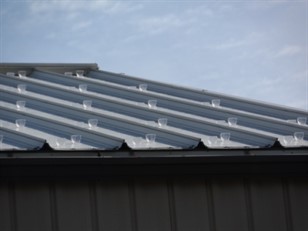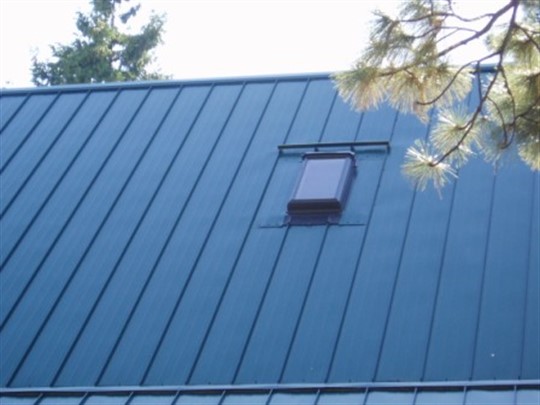Snow Guard Placement
by Jonathan McGaha | 30 September 2015 12:00 am
Where you place snow guards determines their success
 |
| Photo courtesy of SNOBAR |
Snow guards prevent large sheets of snow and ice from avalanching off sloped, glossy-coated metal roofs. They suspend precipitation in a holding field, then let it slowly and safely drop off in small amounts or melt completely. To prevent extensive damage to property and people, they are most commonly installed above entryways, walkways and gathering spots. Snow guard placement will vary from region to region, and will be influenced by roof pitch, the lengths of roof runs and roof features. Their correct placement, location and attachment determine their effectiveness.
“Pedestrian areas are the number one place to consider snow guards on a metal roof,” says Jason Nagaki, vice president, SNOBAR[1], Castle Rock, Colo. “Not only do snow guards protect people from falling snow and ice, but they also protect the owner from potential lawsuits. Other areas that are just as important to protect are lower roof areas, expensive landscaping, parking areas, mechanical equipment, and last but not least, gutters.”
Art, Science, Location
Placement of snow retention devices is both art and science; it relies largely on a snow bank’s compressive strength. “Most also rely on the ‘bridging’ and densification characteristics of a snow bank,” says Rob Haddock, CEO of S-5![2], Colorado Springs, Colo. “This allows some degree of flexibility in placement to achieve functional objectives as well as aesthetic ones, such as alignment with dormers, valley terminations and so on.
 |
| Photo courtesy of SNOBAR |
“A blanket of snow is rather monolithic in behavior. It tends to accumulate to greater depths near its eave end due to rooftop wind dynamics. Additionally, it densifies more toward its eave end as a result of its own weight and other factors. Generally for this reason, both continuous rail-type systems as well as individual cleat-type devices are commonly congested more toward the eave of the roof. This has been done for centuries of time and it works.
Rail-type systems depend to some degree on the tensile and compressive strength of the snow bank to bridge from one row to the next up the slope of the roof. Individual cleat-type devices rely on bridging both up and down the slope, as well as from side-to-side. The frequency (or density) of the device(s) on the roof surface relates directly to the service loads imposed by the blanket of snow-that’s the science part. Once proper frequency is determined by math and engineering, spacing and proximity involves a bit more of the ‘art’ and a little less science.”
Avoiding Errors
One of the leading causes of snow guard failure is an insufficient number of rows of protection. Multiple rows of protection help balance the rows on the roof without overloading the eaves.
“Snow guards should be equally spaced up the slope to control the dynamic movement of the snow and ice,” says Howie Scarboro, national sales manager at SnoBlox-SnoJax, Mechanicsburg, Pa.[3] “One row across the lower edge of the roof is usually not enough protection. The roof should also be load balanced so there is not a tremendous amount of weight just on the lower portions of the roof. Uneven loading can cause structural issues for the panels and the roof system.”
Nagaki agrees that the number one mistake contractors make is installing an under-designed snow guard system. He also warns against installing snow guards in isolated areas such as doorways and pipe vents. However, “If these mistakes happen, in most cases it’s a simple fix usually solved by adding more snow guards to those areas,” he says.
 |
| Photo courtesy of SnoBlox-SnoJax |
Since snow guards are designed to resist a calculated force, their ability to withstand that force should be documented by third-party testing. “This math must be done, and varies with project specifics!” insists Haddock. “To try to resist that force when it is not known is a crapshoot that often results with failure. The second most common mistake is to miscalculate the load by using ground snow rather than roof snow in calculation. While roof snow’s load is often lower than ground, it is also sometimes much greater than ground snow. Another mistake is the use (or lack of it) of factors of safety when matching holding strength of the device to the service load to determine frequency.”
To avoid snow guard placement errors, Nagaki suggests architects and designers have a fully designed snow guard system on roof plans so when contractors bid, there is no question where they should place snow guards or what areas they need to be. “At the very least, I would like to see architects and designers put a note on the roof plan and spec saying that ‘snow guards need to be installed by manufacturer’s recommended design and layout,'” he says.
Always use manufacturers’ web-based tools to determine device placement given the service loads involved. Use these tools so the system is correctly engineered.
 |
| Photo courtesy of S-5! |
- SNOBAR: http://www.snobar.com
- S-5!: http://www.s-5.com
- SnoBlox-SnoJax, Mechanicsburg, Pa.: http://snoblox-snojax.com
Source URL: https://www.metalconstructionnews.com/articles/snow-guard-placement/
